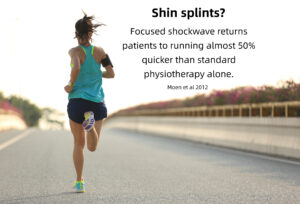Shin Splints
Shin splints is a condition which effects many runners and sports people. There are four different types of shin splints but the most common effects the anterior (front) and medial (inside) of the shin area. It is commonly known as medial tibial stress syndrome (MTSS).
Shin splints occurs in women more than men and approximately 5-35% of runners are likely to get shin splints at some point in their life. The reasons for getting shin splints are varied but it is most commonly caused by a sudden increase in intensity of activity. The muscles in the shin area react due to a sudden increase in running mileage and hence this problem is common in new runners!
Who gets shin splints?
Studies have identified a number of risk factors (Newman et al 2013, Zachary et al 2016):
- Female gender
- Fewer years of running experience
- Previous use of orthotics
- Increase in body mass index
- Increase in navicular drop (this indicates how far the navicular bone (the bone in the arch of the foot) descends on loading the foot)
- Greater hip external rotation movement (the movement of turning the hip outwards)
- Greater ankle plantar flexion (the movement of pointing the foot downwards)
- Previous history of shin splints
Why is shin splints difficult to treat?
Shin splints pain occurs in the soft tissues of the shin. Often the muscles (flexor digitorum longus and tibialis posterior are affected but there are others!) are the source of the pain, but it can be from the muscle, the musculotendinous (muscle/tendon), the tendon or the tenoperiosteal junction (tendon to bone connection), tissues. On rarer occasions it can actually be the bone (stress fracture). So it is difficult to identify the source.
Secondly it is an overuse injury so after rest it can seem okay only to reappear on the next run. So typically it is left a long time before runners seek professional advice. Lastly when it comes to treatment there are many factors which may be part of your recovery plan.
What is the best treatment for shin splints?
- Modify the loading (load the tissue below its reaction level- yes that may mean REST- but not always)
- Identify the factors present and address them. Best way is to see a sports physiotherapist to help you with this.
Common Factors in Shin Splints (no particular order)
- Movement available in ankle joint
- Flexibility of tissues (calf muscles and anterior tibial muscles)
- Footwear (to control or to help absorb load)
- Strength of muscles locally and throughout the limb
- Previous injury (not addressing old injuries leads to the body adapting- we can see patients who load one leg much more than the other- yet still can run until the point of overload is reached)
- Running style (stride length, cadence etc can be important)
What does a physiotherapist do for shin splints?
Treatment can vary between individuals but some techniques address the pain:
- load modification
- exercise rehabilitation including strengthening programs for key muscle groups
- shockwave therapy
- massage
- acupuncture
- ice/heat
- taping
- orthotics

Some address the causation factors and form part of the rehabilitation:
- mobilise stiff joints
- massage/stretch a restricted muscle
- strengthen weak muscles
- retrain poor movement patterns
Addressing the pain does always sort the problem and unfortunately the rehabilitation involves exercise and education. Both of which are influenced by time and compliance!
If you are a runner and you are suffering from any of the above running injuries it might be time to see a Physis Physiotherapist. Online Bookings can be made here or call us on 0131 478 4646. Or email us at: [email protected]



